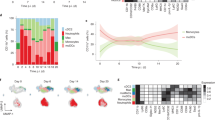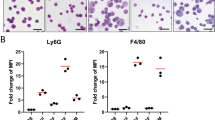Abstract
Macrophage colony-stimulating factor (M-CSF) influences the proliferation and survival of mononuclear phagocytes through the receptor CSF-1R. The adaptor protein DAP12 is critical for the function of mononuclear phagocytes. DAP12-mutant mice and humans have defects in osteoclasts and microglia, as well as brain and bone abnormalities. Here we show DAP12 deficiency impaired the M-CSF-induced proliferation and survival of macrophages in vitro. DAP12-deficient mice had fewer microglia in defined central nervous system areas, and DAP12-deficient progenitors regenerated myeloid cells inefficiently after bone marrow transplantation. Signaling by M-CSF through CSF-1R induced the stabilization and nuclear translocation of β-catenin, which activated genes involved in the cell cycle. DAP12 was essential for phosphorylation and nuclear accumulation of β-catenin. Our results provide a mechanistic explanation for the many defects of DAP12-deficient mononuclear phagocytes.
This is a preview of subscription content, access via your institution
Access options
Subscribe to this journal
Receive 12 print issues and online access
$209.00 per year
only $17.42 per issue
Buy this article
- Purchase on Springer Link
- Instant access to full article PDF
Prices may be subject to local taxes which are calculated during checkout








Similar content being viewed by others
References
Stanley, E.R. et al. Biology and action of colony-stimulating factor-1. Mol. Reprod. Dev. 46, 4–10 (1997).
Chitu, V. & Stanley, E.R. Colony-stimulating factor-1 in immunity and inflammation. Curr. Opin. Immunol. 18, 39–48 (2006).
Hamilton, J.A. Colony-stimulating factors in inflammation and autoimmunity. Nat. Rev. Immunol. 8, 533–544 (2008).
Sherr, C.J. et al. The c-fms proto-oncogene product is related to the receptor for the mononuclear phagocyte growth factor, CSF-1. Cell 41, 665–676 (1985).
Downing, J.R., Rettenmier, C.W. & Sherr, C.J. Ligand-induced tyrosine kinase activity of the colony-stimulating factor 1 receptor in a murine macrophage cell line. Mol. Cell. Biol. 8, 1795–1799 (1988).
Sengupta, A. et al. Identification and subcellular localization of proteins that are rapidly phosphorylated in tyrosine in response to colony-stimulating factor 1. Proc. Natl. Acad. Sci. USA 85, 8062–8066 (1988).
Hamilton, J.A. CSF-1 signal transduction. J. Leukoc. Biol. 62, 145–155 (1997).
Yeung, Y.G. & Stanley, E.R. Proteomic approaches to the analysis of early events in colony-stimulating factor-1 signal transduction. Mol. Cell. Proteomics 2, 1143–1155 (2003).
Tushinski, R.J. & Stanley, E.R. The regulation of mononuclear phagocyte entry into S phase by the colony stimulating factor CSF-1. J. Cell. Physiol. 122, 221–228 (1985).
Roussel, M.F. Regulation of cell cycle entry and G1 progression by CSF-1. Mol. Reprod. Dev. 46, 11–18 (1997).
Tushinski, R.J. et al. Survival of mononuclear phagocytes depends on a lineage-specific growth factor that the differentiated cells selectively destroy. Cell 28, 71–81 (1982).
Wiktor-Jedrzejczak, W. et al. Total absence of colony-stimulating factor 1 in the macrophage-deficient osteopetrotic (op/op) mouse. Proc. Natl. Acad. Sci. USA 87, 4828–4832 (1990).
Cecchini, M.G. et al. Role of colony stimulating factor-1 in the establishment and regulation of tissue macrophages during postnatal development of the mouse. Development 120, 1357–1372 (1994).
Kondo, Y., Lemere, C.A. & Seabrook, T.J. Osteopetrotic (op/op) mice have reduced microglia, no Aβ deposition, and no changes in dopaminergic neurons. J. Neuroinflammation 4, 31 (2007).
Wegiel, J. et al. Reduced number and altered morphology of microglial cells in colony stimulating factor-1-deficient osteopetrotic op/op mice. Brain Res. 804, 135–139 (1998).
Witmer-Pack, M.D. et al. Identification of macrophages and dendritic cells in the osteopetrotic (op/op) mouse. J. Cell Sci. 104, 1021–1029 (1993).
Lanier, L.L. DAP10- and DAP12-associated receptors in innate immunity. Immunol. Rev. 227, 150–160 (2009).
Paloneva, J. et al. Loss-of-function mutations in TYROBP (DAP12) result in a presenile dementia with bone cysts. Nat. Genet. 25, 357–361 (2000).
Paloneva, J. et al. Mutations in two genes encoding different subunits of a receptor signaling complex result in an identical disease phenotype. Am. J. Hum. Genet. 71, 656–662 (2002).
Kaifu, T. et al. Osteopetrosis and thalamic hypomyelinosis with synaptic degeneration in DAP12-deficient mice. J. Clin. Invest. 111, 323–332 (2003).
Humphrey, M.B. et al. The signaling adapter protein DAP12 regulates multinucleation during osteoclast development. J. Bone Miner. Res. 19, 224–234 (2004).
Nataf, S. et al. Brain and bone damage in KARAP/DAP12 loss-of-function mice correlate with alterations in microglia and osteoclast lineages. Am. J. Pathol. 166, 275–286 (2005).
Paloneva, J. et al. DAP12/TREM2 deficiency results in impaired osteoclast differentiation and osteoporotic features. J. Exp. Med. 198, 669–675 (2003).
Faccio, R., Zou, W., Colaianni, G., Teitelbaum, S.L. & Ross, F.P. High dose M-CSF partially rescues the Dap12−/− osteoclast phenotype. J. Cell. Biochem. 90, 871–883 (2003).
Zou, W. et al. Syk, c-Src, the αvβ3 integrin, and ITAM immunoreceptors, in concert, regulate osteoclastic bone resorption. J. Cell Biol. 176, 877–888 (2007).
Hamerman, J.A., Tchao, N.K., Lowell, C.A. & Lanier, L.L. Enhanced Toll-like receptor responses in the absence of signaling adaptor DAP12. Nat. Immunol. 6, 579–586 (2005).
Stanley, E.R. Murine bone marrow-derived macrophages. Methods Mol. Biol. 75, 301–304 (1997).
Klappacher, G.W. et al. An induced Ets repressor complex regulates growth arrest during terminal macrophage differentiation. Cell 109, 169–180 (2002).
Xaus, J. et al. Molecular mechanisms involved in macrophage survival, proliferation, activation or apoptosis. Immunobiology 204, 543–550 (2001).
Owens, D.M. & Keyse, S.M. Differential regulation of MAP kinase signalling by dual-specificity protein phosphatases. Oncogene 26, 3203–3213 (2007).
Tetsu, O. & McCormick, F. Beta-catenin regulates expression of cyclin D1 in colon carcinoma cells. Nature 398, 422–426 (1999).
Shtutman, M. et al. The cyclin D1 gene is a target of the β-catenin/LEF-1 pathway. Proc. Natl. Acad. Sci. USA 96, 5522–5527 (1999).
He, T.C. et al. Identification of c-MYC as a target of the APC pathway. Science 281, 1509–1512 (1998).
Clevers, H. Wnt/β-catenin signaling in development and disease. Cell 127, 469–480 (2006).
Lilien, J. & Balsamo, J. The regulation of cadherin-mediated adhesion by tyrosine phosphorylation/dephosphorylation of β-catenin. Curr. Opin. Cell Biol. 17, 459–465 (2005).
Piedra, J. et al. Regulation of β-catenin structure and activity by tyrosine phosphorylation. J. Biol. Chem. 276, 20436–20443 (2001).
Wang, L. et al. 'Tuning' of type I interferon-induced Jak-STAT1 signaling by calcium-dependent kinases in macrophages. Nat. Immunol. 9, 186–193 (2008).
Hu, X., Chen, J., Wang, L. & Ivashkiv, L.B. Crosstalk among Jak-STAT, Toll-like receptor, and ITAM-dependent pathways in macrophage activation. J. Leukoc. Biol. 82, 237–243 (2007).
van Buul, J.D., Anthony, E.C., Fernandez-Borja, M., Burridge, K. & Hordijk, P.L. Proline-rich tyrosine kinase 2 (Pyk2) mediates vascular endothelial-cadherin-based cell-cell adhesion by regulating β-catenin tyrosine phosphorylation. J. Biol. Chem. 280, 21129–21136 (2005).
Li, X., Dy, R.C., Cance, W.G., Graves, L.M. & Earp, H.S. Interactions between two cytoskeleton-associated tyrosine kinases: calcium-dependent tyrosine kinase and focal adhesion tyrosine kinase. J. Biol. Chem. 274, 8917–8924 (1999).
Zou, W., Reeve, J.L., Liu, Y., Teitelbaum, S.L. & Ross, F.P. DAP12 couples c-Fms activation to the osteoclast cytoskeleton by recruitment of Syk. Mol. Cell 31, 422–431 (2008).
Pixley, F.J. & Stanley, E.R. CSF-1 regulation of the wandering macrophage: complexity in action. Trends Cell Biol. 14, 628–638 (2004).
Mocsai, A. et al. Integrin signaling in neutrophils and macrophages uses adaptors containing immunoreceptor tyrosine-based activation motifs. Nat. Immunol. 7, 1326–1333 (2006).
Scheller, M. et al. Hematopoietic stem cell and multilineage defects generated by constitutive β-catenin activation. Nat. Immunol. 7, 1037–1047 (2006).
Melcher, M. et al. Essential roles for the Tec family kinases Tec and Btk in M-CSF receptor signaling pathways that regulate macrophage survival. J. Immunol. 180, 8048–8056 (2008).
Shinohara, M. et al. Tyrosine kinases Btk and Tec regulate osteoclast differentiation by linking RANK and ITAM signals. Cell 132, 794–806 (2008).
Gilfillan, S., Ho, E.L., Cella, M., Yokoyama, W.M. & Colonna, M. NKG2D recruits two distinct adapters to trigger NK cell activation and costimulation. Nat. Immunol. 3, 1150–1155 (2002).
Kitamura, T. et al. Retrovirus-mediated gene transfer and expression cloning: powerful tools in functional genomics. Exp. Hematol. 31, 1007–1014 (2003).
Giurisato, E. et al. Phosphatidylinositol 3-kinase activation is required to form the NKG2D immunological synapse. Mol. Cell. Biol. 27, 8583–8599 (2007).
Chen, X. et al. A critical role for DAP10 and DAP12 in CD8+ T cell-mediated tissue damage in large granular lymphocyte leukemia. Blood 113, 3226–3234 (2009).
Acknowledgements
We thank D.M. Ornitz (Washington University School of Medicine) for the LEF-luc-pGL3 reporter plasmid; H.S. Earp III (University of North Carolina, Chapel Hill) for the plasmid encoding CRNK; T. Rolink (University of Basel) for IgM anti-CD4 and IgM anti-CD8; S. Gilfillan for critical reading of the manuscript; C. Laudanna and B. Rossi for advice on cell adhesion experiments; and Pfizer for the Pyk2 inhibitor PF 431396. Supported by the US National Institutes of Health (R01 GM077279 to M.C. and U54 AI1057160 to S.L.S.), Nobel Project Fondazione Cariplo (W.V.) and Fondazione Nocivelli (P.L.P.).
Author information
Authors and Affiliations
Contributions
K.O. and I.R.T. designed and did experiments; P.L.P., W.V., T.A. and M.M. did and interpreted immunohistochemistry experiments; E.C., I.T. and A.S.S. did and interpreted adhesion assays and confocal microscopy studies; S.L.S. and T.T. provided reagents and expression data; and M.C. directed the research and wrote the paper.
Corresponding author
Supplementary information
Supplementary Text and Figures
Supplementary Figures 1–7, Supplementary Tables 1–2 and Supplementary Methods (PDF 523 kb)
Rights and permissions
About this article
Cite this article
Otero, K., Turnbull, I., Poliani, P. et al. Macrophage colony-stimulating factor induces the proliferation and survival of macrophages via a pathway involving DAP12 and β-catenin. Nat Immunol 10, 734–743 (2009). https://doi.org/10.1038/ni.1744
Received:
Accepted:
Published:
Issue Date:
DOI: https://doi.org/10.1038/ni.1744
This article is cited by
-
TREM2 deficiency impairs the energy metabolism of Schwann cells and exacerbates peripheral neurological deficits
Cell Death & Disease (2024)
-
Regulation of Microglial Activation by Wnt/β-Catenin Signaling After Global Cerebral Ischemia in Mice
Molecular Neurobiology (2024)
-
WNT Signaling in Stem Cells: A Look into the Non-Canonical Pathway
Stem Cell Reviews and Reports (2024)
-
Microglial senescence contributes to female-biased neuroinflammation in the aging mouse hippocampus: implications for Alzheimer’s disease
Journal of Neuroinflammation (2023)
-
Roles of tumor-associated macrophages in anti-PD-1/PD-L1 immunotherapy for solid cancers
Molecular Cancer (2023)



